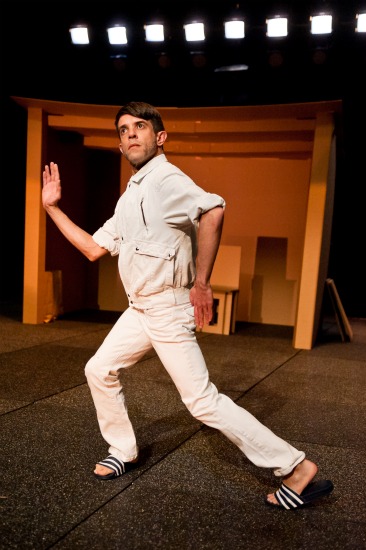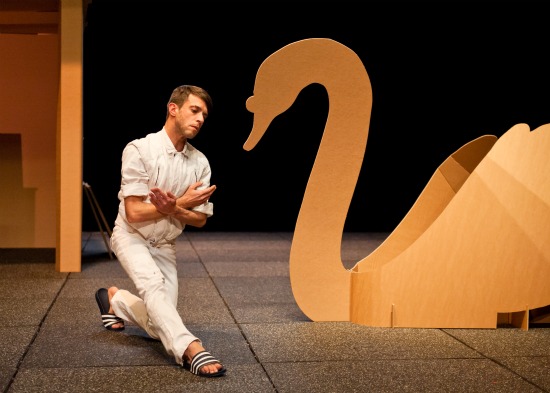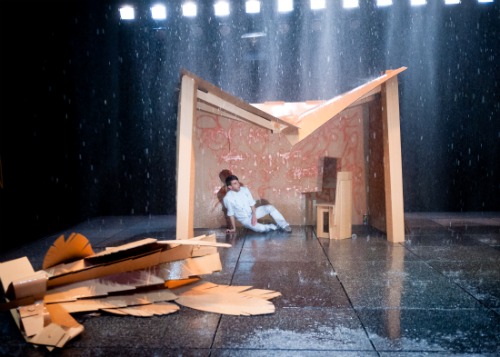Somewhere out there, there must be people who, happening on—or dragged to— a contemporary performance, will venture, “but is it dance?” Others more confident will re-frame the question as an assertion, possibly an outraged one. But anyone regularly attending productions in New York’s forward-looking theaters and the equivalent in Europe will have become accustomed to the wide-armed, eclectic embrace of postmodern art. You don’t sit in New York Live Arts’s black-box performing space watching Francisco Camacho struggle through Meg Stuart’s BLESSED and analyze the height of his jumps or the arch of his feet.
You wonder instead how Camacho could have lived through over 75 performances of BLESSED in Europe—39 of them in 2007, the year Stuart created the piece. In this Beckettian dystopia, he devolves from a stiff, spruce Everyman, marching slowly around like the protagonist of a domesticated video game, into a homeless, primal creature. Like the couple in Stuart’s 2006 Forgeries, Love, and Other Matters, he has come to a place—in this case, perhaps, his modest home—that turns into a disaster area.
Stuart, an American dancer-choreographer who works in Brussels and Berlin, named her company Damaged Goods after the insightful closing line of Burt Supree’s 1991 review of her Disfigure Study in the Village Voice: “But it’s failure that absorbs Stuart – the body’s stubborn, fumbling thickness, its sticky desires and cruel inefficacies. And everyone is shown as damaged goods.”
It’s also worth remembering that Stuart was born in New Orleans and that she must have begun working on BLESSED not long after Katrina wreaked its havoc on the city in August, 2005. You can tell from the moment Jan Maertens casts a sunny glow on Doris Dziersk’s installation, that Camacho’s is a fragile environment. On big, thick gray squares of what must be a sponge-like material sit a palm tree, a large swan, and an open-sided shack with a chair inside it. All are made of unpainted, corrugated cardboard. Camacho, wearing a white shirt and trousers and striped beach sandals, walks slowly and mechanically about the property in straight lines, setting each foot carefully, heel first, and slightly scuffing the other foot through. He swings his bent arms carefully with each step. At times, he too seems constructed out of cardboard—flat pieces assembled to give the illusion of three-dimensionality.
He surveys his domain —leaning briefly against the tree, kneeling before the swan (in a sly, semi-simulation of ballet’s Swan Queen pose). The soft sounds in Hahn Rowe’s electronic score become louder, almost clangorous. Camacho enters his house and sit sideways on the chair, staring out toward us. Through the music’s deeper tones, a dripping sound becomes more and more persistent. The slim yellow hoses hanging along a side wall of the stage turn out to carry water to perforated overhead pipes.
It rains and rains and rains. Sometimes the deluge slackens or stops, but always starts again. The saturated palm leaves droop until the tree trunk breaks. The swan’s neck bends slowly to touch the ground. The house’s roof caves in. Camacho spray paints messages on its walls in red. At that point, he changes clothes and dons an extraordinary red-bearded mask and hat (costumes by Jean-Paul Lespagnard) that hides everything but his eyes. Is this an anti-rain ritual, or the brave rambles of a drunken carnival figure who walks with a loose, slouchy swagger?
Having embraced the broken tree, the man attempts to cope. Now clad in a transparent raincoat over briefs and kneepads, he tears up the fallen cardboard structures, piling up the flat, soaked pieces and assembling makeshift shelters, one so small it’s like a sandwich with him as the filling.
Then: a diversion, maybe a memory. While he crouches, his mouth held open in a toothy grimace by some kind of device that makes him resemble a gibbering monkey, a Mardi Gras vision appears: a glamorous Asian woman (Katomi Nishiwaki) who parades around the drenched space in high-heeled white boots. Under a bright robe, her iridescent body suit gleams darkly; her headdress is feathered and huge. As she struts and turns giddily, the smile never leaves her face.
After she goes, Camacho finally hits bottom. On all fours, unseeing, he crawls with his toes tucked under, groping with little scrabbling motions of his fingers on the puddled ground. At one point, he gets stuck—going forward a little, backing up, going forward, backing up. His whole body is twitching by the time he manages to stand upright to music that has become increasingly loud and percussive.
The denouement has the semblance of a botched resurrection. Camacho poses like a baroque Saint Sebastian awaiting the arrows—arms held out or crossed over his chest, eyes heavenward. He remains passive while Abraham Hurtado, rising from a seat in the front row, starts dressing him in odd assortments of clothing, eyeing his contributions and whipping them off almost immediately—more like a dyspeptic perfectionist designer than a relief worker. A sateen team jacket and visored cap? No, won’t do. In the end, Hurtado strips away the last, most outrageously unsuitable outfit and dresses Camacho in a raincoat again, providing him with a towel, red-framed shades, and sandals just like the ones he lost.
The survivor regains his original walk, but his movements change slightly in response to the wet surface and the altered environment. The percussion begins again, along with windy instrumental voices. Then, suddenly, the music stops and so does he. Just freezes in mid-stride, his head turned to stare at us. The lights go out.
Camacho, who had a hand in the creation of BLESSED, enacts this harrowing scenario magnificently. At times, you can hardly bear to watch him labor at constructing something out of total ruin. Afterward, as I was walking along 19th Street past NYLA’s floor-to-ceiling window, choreographer-dancer Jody Melnick, chatting inside, came close to the glass and mouthed to me, “Oh my God!” And I mouthed it back. Dancing? Did anyone want to ask?




Love this!
Thank you!
This was my first time to see Meg Stuart’s work. It reminded me of many ways of what my Refugee Dancers have lived through and I found it sometimes painful but I admired the continual persistence of the performer and the choreography. I can’t wait to see more